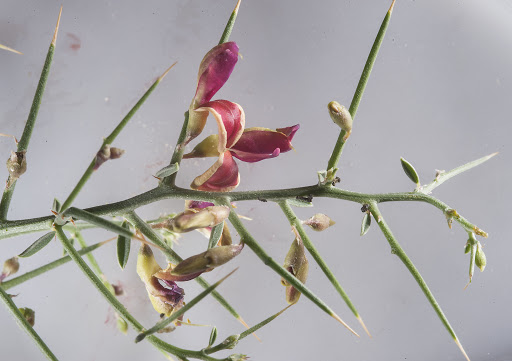Camelthorn

Camelthorn
(Alhagi maurorum)
Priority: - Prevent / EDRR
Tags: Terrestrial
Identification and Reproduction
Identification:
- Camelthorn is a perennial shrub that ranges from 0.6-0.9 m tall.
- It bears sharp yellow spines that can be as long as 5 cm.
- This plant also has leaves that are alternately arranged, small and lanceolate.
- Produces small pea-like flowers that are brown or dark maroon. Blooms occur from June through August.
- Seedpods are segmented and are constricted between each individual seed, tapering to a point.
Reproduction:
- Is able to reproduce vegetatively but also seeds.
- Seedpods will shatter and release half-moon shaped seeds, these seeds are easily dispersed by water.
- It is a very aggressive colonizer with its creeping roots constantly expanding outwards.
- Camelthorn is a deep rooted plant that develops a very extensive rhizomatous root system.
- Roots can penetrate upto 2 m deep and over 12 m in length.
Habitat & Ecology
- Camelthorn will invade dry, agricultural areas and riverbanks.
- This plant is also very hardy and tends to persist through drought, high temperatures, frost, sandstorms and changes in salinity.
- Currently this plant has been listed as a high risk species in Canada and has not yet established.
Impacts
Social:
- The deep and widespread root system makes the plant very difficult to control especially in crop ranges.
- It out-competes crops for both nutrients and water.
- Impalatable to livestock.
- Camelthorn seeds tends to mix and contaminate alfalfa crop seeds.
Ecological:
- Its deep roots are able to reach water tables up to 2 m deep. In shallow or arid environments this may be problematic as there is potential to exhaust the water supply.
- If a dense thicket establishes it will prevent animal mobility.
Management
Prevention is a high priority for this plant.
- Research has been shown that mechanical and manual control is difficult because of the thorns and is ineffective.
- Use clean, high-quality seed mixtures that are certified.
- Since camelthron has yet to establish in BC, it is currently listed as an Early Detection and Rapid Response (EDRR) invasive species and being closely monitored.
- If you think you have seen this plant pease report it.
Resources
The Oregon Department of Agriculture has performed a Plant Pest Risk Assessment for Camelthron, download here.
For more historical background on camelthorn check out the Invasive Species Compendium datasheet on Alhagi maurorum (camelthorn) here.
Header photo (Umm Bab).




